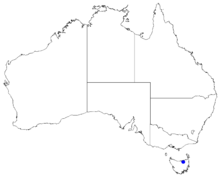Boronia hemichiton
Boronia hemichiton, commonly known as Mt Arthur boronia[2] is a plant in the citrus family Rutaceae and is endemic to Tasmania. It is an erect, woody shrub with compound leaves and pink or white, four-petalled flowers.
| Mt Arthur boronia | |
|---|---|
 | |
| Boronia hemichiton in the Royal Tasmanian Botanical Gardens | |
| Scientific classification | |
| Kingdom: | Plantae |
| Clade: | Tracheophytes |
| Clade: | Angiosperms |
| Clade: | Eudicots |
| Clade: | Rosids |
| Order: | Sapindales |
| Family: | Rutaceae |
| Genus: | Boronia |
| Species: | B. hemichiton |
| Binomial name | |
| Boronia hemichiton | |
 | |
| Occurrence data from Australasian Virtual Herbarium | |
Description
Boronia hemichiton is an erect, woody shrub that grows to about 1.5 m (5 ft) high and has branches with minute, bristle like hairs between the leaf bases and small, blunt glands. The leaves have three, five or seven leaflets and are 9–12 mm (0.4–0.5 in) long and 12–16 mm (0.5–0.6 in) wide in outline on a petiole 1.5–2.5 mm (0.06–0.1 in) long. The end leaflet is 2.5–8 mm (0.1–0.3 in) long and 0.5–1 mm (0.02–0.04 in) wide and the side leaflet are similar but longer. The flowers are pink, sometimes white and are arranged singly or in groups of up to three in leaf axils, the groups on a peduncle 1–2 mm (0.04–0.08 in) long. The four sepals are narrow triangular, 0.5–1.5 mm (0.02–0.06 in) long and about 0.5 mm (0.02 in) wide. The four petals are narrow egg-shaped with a pointed tip, 4.5–5.5 mm (0.2–0.2 in) long, 1.2–3 mm (0.05–0.1 in) wide and hairy on the outside. Flowering occurs from October to January and the fruit is a glabrous capsule 2.5–3 mm (0.1–0.1 in) long and 1.5–2 mm (0.06–0.08 in) wide.[2][3][4]
Taxonomy and naming
Boronia hemichiton was first formally described in 2003 by Marco F. Duretto who published the description in Muelleria from a specimen collected on Mount Arthur.[5][3] The specific epithet (hemichiton) is derived from the Ancient Greek prefix hemi- meaning "half"[6]:392 and chiton meaning "tunic" or "garment worn next to the skin",[6]:362 referring to the leaves which are only hairy near the base.[3]
Distribution and habitat
The Mt Arthur boronia grows in the wet heath or scrub. It is only known from two subpopulations on Mt Arthur.[2][4]
Conservation
Boronia hemichiton is listed as "vulnerable" under the Commonwealth Government Environment Protection and Biodiversity Conservation Act 1999 (EPBC) Act and as "endangered" under the Tasmanian Government Threatened Species Protection Act 1995.The main threats to the species are dieback caused by Phytophthora cinnamomi, inappropriate fire regimes and changes in water flow.[4]
References
- "Boronia hemichiton". Australian Plant Census. Retrieved 16 March 2020.
- "Boronia hemichiton" (PDF). Tasmanian Government Department of Primary Industries, Parks, Water and Environment. Retrieved 6 February 2019.
- Duretto, Marco F. (2003). "Notes on Boronia (Rutaceae) in eastern and northern Australia" (PDF). Muelleria. 17: 87–88. Retrieved 6 February 2019.
- "Approved Conservation Advice for Boronia hemichiton (Mt Arthur Boronia)" (PDF). Australian Government Department of the Environment. Retrieved 6 February 2019.
- "Boronia hemichiton". APNI. Retrieved 6 February 2019.
- Brown, Roland Wilbur (1956). The Composition of Scientific Words. Washington, D.C.: Smithsonian Institution Press.
